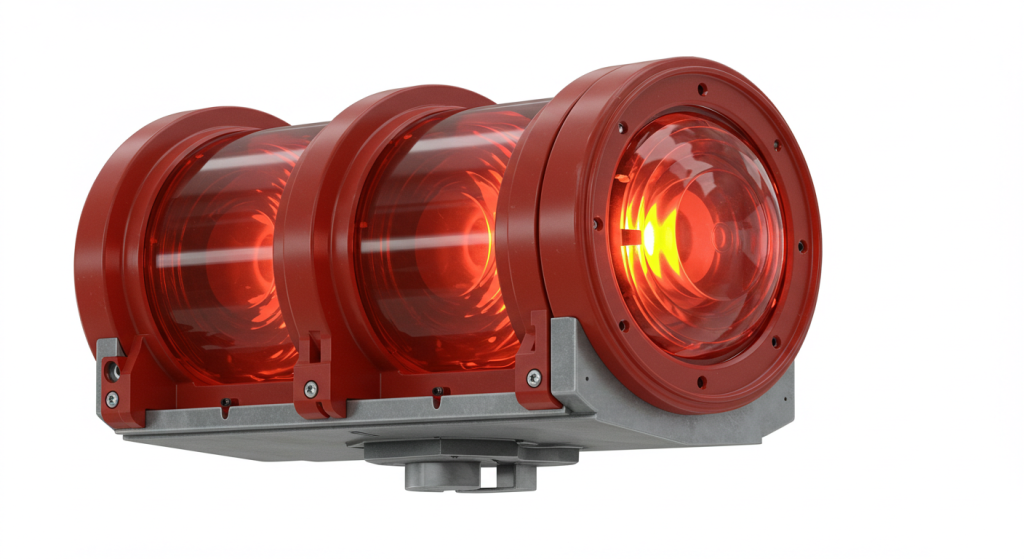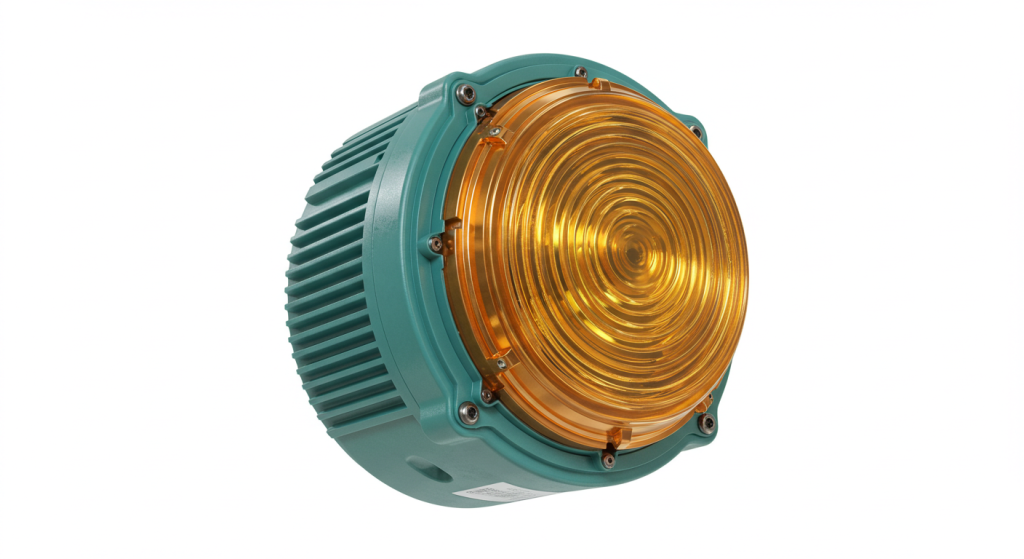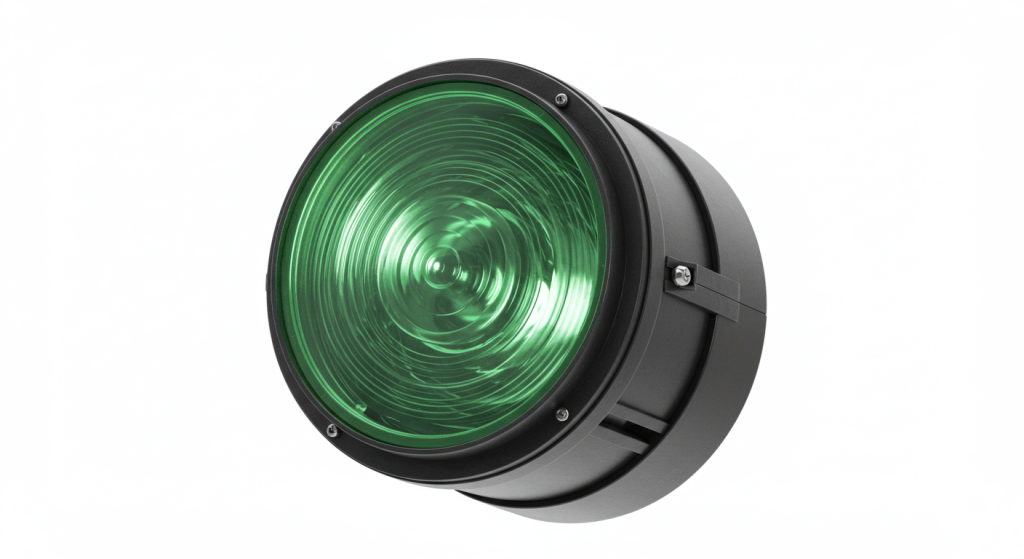Illuminating the Runways: A Deep Dive into LED Rotating Beacon Lights for Aviation
The quest for optimal visibility in aviation is never-ending, and one vital component in this pursuit is the rotating beacon light. When considering the best options, many professionals and enthusiasts often ask, “Which is the best led rotating beacon light?” This inquiry isn’t just about brightness; it’s about reliability, energy efficiency, and compliance with aviation safety standards. The decision making process should also include an evaluation of the overall costs, including running costs and the importance of eco-friendly options like [Why to Buy Solar Taxiway Lights], which contribute to both safety and sustainability. Factors such as the lifespan of the light, its ease of installation, and the robustness of its construction are equally important. Additionally, comparing various product specifications, performance and reviews are essential steps in the selection process.

Understanding the Role of Rotating Beacon Lights in Aviation
Rotating beacon lights are a fundamental element of airport infrastructure, serving as a visual aid for pilots navigating to and from airports, especially during nighttime or poor visibility conditions. These lights are designed to rotate, emitting a high-intensity beam of light that can be seen from significant distances. While modern technology has introduced several alternatives, traditional rotating beacons remain relevant due to their reliability and the familiarity pilots have with their characteristics. The role of these beacons extends beyond mere visual guidance. They offer an added layer of security. They also serve as a clear indication that an airport is operational and available for use. This is a critical function especially during unexpected weather or in cases of emergency. The consistent illumination these beacons provide is reassuring to pilots.
The Evolution of Airport Beacons
Historically, airport beacons used incandescent bulbs, which required frequent maintenance and consumed a considerable amount of energy. The advent of LED technology has transformed airport beacon lights, providing a more efficient, long-lasting, and cost-effective solution. This evolution has not only improved the operational efficiency of airports but has also contributed to greater safety due to enhanced visibility and reduced downtime. LEDs also have a much higher efficiency rating. They use a lot less power to generate an equal amount of light. They have also decreased maintenance time for airport staff.

Do Airports Still Use Rotating Beacons?
The question of whether airports still use rotating beacons often arises as newer technologies emerge. The answer is yes, rotating beacons continue to be a standard feature at many airports, though there are changes in the kind of rotating beacon lights. Despite the availability of advanced lighting systems, such as strobes and flashing lights, rotating beacons maintain a unique significance in the aviation community due to their established meaning and reliability. Here are the key reasons for this continued usage:
- Established Significance: Pilots are trained to recognize and interpret the rotating beam of an airport beacon, making it a familiar and trusted navigation aid.
- Reliability: Rotating beacons are known for their dependability, often functioning even under harsh weather conditions.
- Clear Identification: The rotating motion is easily distinguishable from other lighting sources, providing clear identification of an airport’s location.
- Wide Visibility: The rotating beam covers a broad range of angles, ensuring visibility from various directions and altitudes.
- Complementary Technology: They can work alongside other newer lighting systems, offering multiple layers of visual guidance.
- Cost Effective Retrofits: Many airports have switched to LED technology while still maintaining the rotating aspect of the beacon light.
While the technology may have advanced, the fundamental function of the rotating beacon remains relevant. Many airports are updating to LED technology and may use additional lighting systems for approach, but the core of what makes an airport beacon recognizable has stayed the same. While newer options might offer some advantages, the established purpose of these beacons has kept them firmly in place.
What is a Rotating Beacon?
A rotating beacon is a specialized lighting device designed to emit a strong beam of light that sweeps across a defined area, thereby making the light source visible from various angles. It is characterized by its rotating mechanism, which projects light 360 degrees around its base. The rotational speed and light intensity are often controlled to meet specific operational needs. Understanding the technical aspect and function of these lights is essential. The rotating beacon has been a core part of aviation for a very long time. It’s essential to understand how it works to appreciate why it’s still used today.
Key Components of a Rotating Beacon
- Light Source: The source of light, which can be incandescent, halogen, or, most commonly today, LED. LED is preferred for its efficiency.
- Rotating Mechanism: A motor or drive system rotates the light source within the beacon housing.
- Lens or Reflector: This component focuses and directs the light beam, enhancing visibility and optimizing the coverage.
- Housing: A weather-resistant enclosure that protects the light source and rotating mechanism.
- Power Supply: A system that provides power to both the light and the rotating motor.

How Rotating Beacons Work
The core principle of the rotating beacon is the use of a rotating light source, which is mounted onto a mechanical system. As the light source rotates, the concentrated beam of light sweeps around the horizon, becoming intermittently visible to observers. The rate of rotation and beam characteristics are designed to enhance the visibility and recognizability of the light. The movement of the beacon makes it easily recognizable from a distance as a beacon. Because of this the movement itself is just as important as the brightness of the light.
Types of Rotating Beacons
- Airport Beacons: Typically installed at airports to guide pilots. The color is usually white and green.
- Aviation Hazard Beacons: Used to mark tall structures like communication towers, often emitting a red light.
- Emergency Beacons: Used by emergency services, such as police or fire departments, often with blue or red colors.
The fundamental concept of the rotating beacon—a light source that rotates to project a beam—is simple yet effective, and it is this function that has been the keystone of the aviation industry for so many years. From the earliest beacons to modern LED versions, they are the symbol of safe skies.
What is the Purpose of the Beacon Light?
The primary purpose of a beacon light in the aviation context is to serve as a visual aid, guiding pilots and indicating the presence and operational status of an airport. The beacon is more than just a light. It serves several critical functions in air traffic safety. Here are the main purposes:
Key Functions of Airport Beacon Lights
- Airport Identification: Beacons allow pilots to easily identify an airport’s location, especially in low visibility conditions or at night.
- Operational Status: A lit beacon typically indicates that an airport is open for operation and available for use.
- Navigation Aid: It helps pilots find their way to and from the airport, especially in areas with limited visual cues.
- Warning Signal: In some scenarios, a beacon may also serve as a warning to pilots of the airport’s presence to prevent accidental flyovers.
- Emergency Communication: Beacons can sometimes indicate specific alerts such as emergencies or airport closures through special flash sequences.
Beacon Lighting Patterns and Their Significance
- Civilian Airport: The civilian beacon light pattern is typically a combination of white and green flashes.
- Military Airport: The military beacon typically displays a combination of two white flashes followed by a green flash.
- Heliport: A heliport beacon usually emits white, yellow, and green flashes.
- Emergency Beacon: This would use a different flashing rate and the color is often red, blue or amber.
Situations Where Beacons are Crucial
- Night Flying: Beacons become especially important during nighttime operations to make airports visible.
- Low Visibility: They help pilots find airports in hazy, foggy, or rainy conditions.
- Remote Areas: Beacons are crucial for identifying airports in remote areas with limited ground lighting.
- Emergency Situations: They help pilots find a safe landing spot in case of emergencies.
The beacon light’s purpose is multifaceted, working both to guide pilots safely to their destinations and to communicate important information about an airport’s status. The reliability and visibility of a good quality beacon light are critical to any airport. It helps pilots to orient themselves, to avoid potential hazards, and to maintain the flow of air traffic.
What is the Meaning of Airport Beacon Lights?
Airport beacon lights are not just sources of illumination; they are also a visual language used in aviation to convey specific information to pilots. Understanding the meaning behind airport beacon lights is crucial for safe and efficient air navigation. The color, flash pattern, and presence of an airport beacon can tell a pilot the status of an airport, as well as the nature of that airport. Here’s a breakdown of the various meanings:
Color Codes
- White Light: White light is commonly used to indicate that the airport is open and available for use. It is a key component of the visual signal for pilots.
- Green Light: The presence of green light usually means that the beacon light is at a civil airport. It also means the airport is generally operational.
- Amber Light: This usually denotes an emergency situation, some hazards, or a temporary closure.
- Blue Light: Blue lights are normally used to indicate a police, fire or other emergency service facility.
Flash Patterns
- Rotating White and Green: Indicates a civil airport open for public use.
- Dual White Flashes Followed by Green: Denotes a military airport.
- White, Yellow, and Green: Used at heliports.
- Alternating Flashes: May indicate an emergency situation or temporary closure.
What The Absence of Beacons May Signify
- Closure: An airport with no beacon light may indicate that the airport is closed or not operational.
- Limited Service: Some airports may have limited nighttime operations or only operate seasonally.
- Malfunctions: It could also indicate that a malfunction has occurred. This would be an unexpected absence of light.
The Importance of Understanding
Pilots are trained to understand and interpret airport beacon lights so that they can safely operate their aircraft. A misinterpretation of a beacon’s meaning could lead to a critical error, putting lives at risk. The use of beacon lights is standardized across the world for this reason, allowing pilots to safely fly, knowing that the same beacon will mean the same thing regardless of location.
In short, airport beacon lights act as a visual communication tool, conveying the status and type of facility to pilots. Knowing the visual language of these beacon lights is important for all pilots. It ensures that they can respond correctly and safely.
Airport Beacon Lights Price
The price of airport beacon lights can vary significantly depending on the technology, quality, and specific features of the beacon. Understanding the different factors influencing the price is essential for making informed decisions. The following is a basic guide to the costs associated with beacon lights for airports, taking into account the different factors.
Factors Affecting Price
- Type of Beacon: LED rotating beacons are generally more expensive than traditional incandescent or halogen beacons due to their advanced technology and efficiency.
- Light Intensity: Beacons with higher light intensity and wider coverage tend to cost more than those with lower intensity.
- Quality and Brand: Reputable brands that use durable components and reliable technology typically command higher prices.
- Features: Additional features such as remote monitoring, built-in diagnostics, or weather-proofing add to the cost.
- Solar Power: [Solar Powered Obstruction Lights], which are ideal for remote locations where power may be difficult to access, can be initially more expensive due to the solar equipment. However the long run operation costs are lower.
- Installation Cost: The cost to install the system, mount the light, and wire the connections can vary. The complexity of the location affects pricing.
Price Ranges
Here are estimated price ranges for various types of airport beacon lights:
| Type of Beacon Light | Estimated Price Range (USD) | Description |
|---|---|---|
| Traditional Incandescent or Halogen Beacon | $500 – $1,500 per unit | Older technology, less efficient, lower up-front cost |
| Standard LED Rotating Beacon | $1,500 – $5,000 per unit | Energy efficient, long-lasting, more durable than older versions |
| High-Intensity LED Rotating Beacon | $5,000 – $15,000+ per unit | Higher visibility range, best for larger airports |
| Solar Powered LED Beacon Light | $2,000 – $10,000+ per unit | Includes solar panels, batteries, and the light unit, good for remote areas |
Additional Costs
- Installation: Professional installation of these systems can cost anywhere from $500 to $2,000, depending on the complexity of the job.
- Maintenance: Regular maintenance is required to ensure the beacon works reliably. This cost depends on how extensive the repairs are.
- Permits and Approvals: Fees may be required to obtain permits to install and operate the system based on local laws.
- Replacement Parts: The need for replacement parts and equipment can add up over the long term.
How to Get the Best Price
- Compare Quotes: Request quotes from multiple suppliers to get competitive pricing.
- Consider LED Technology: While more expensive initially, LED options offer long-term cost savings.
- Plan Ahead: Purchasing in advance allows more time to compare pricing and schedule installation.
- Negotiate: Be prepared to negotiate, especially for larger orders.
- Choose Quality: Ensure that the systems meet the required regulations, even if they cost slightly more.
The cost of airport beacon lights is an investment in safety and operational efficiency. Evaluating all cost factors is important. Prioritizing quality over price is crucial to avoid issues with compliance and maintenance. Choosing reliable suppliers is an important part of this process. Careful planning will result in a reliable system that will serve the airport for many years.
In summary, the selection of **which is the best led rotating beacon light** hinges upon a thorough assessment of various factors, including the type of airport, operational requirements, budget, and commitment to energy-efficient solutions. The decision-making should consider the use of options like [Why to Buy Solar Taxiway Lights] for supplementary areas and also ensure that the selected beacons meet the standards of aviation regulators. The role that these lights play extends beyond mere illumination; they are essential tools for navigation, safety, and operational efficiency. Modern lights such as [Solar Powered Obstruction Lights] have increased the safety and accessibility of the aviation industry. By considering these elements, airports can make smart choices for the lighting system. Thus, they can ensure the safety and reliability of their operations and the safe navigation of all pilots.